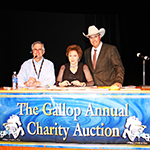Leaders from six equine organizations shared thoughts on the horse community at large with APHA members at the Horse Community Symposium, which took place February 26 at the 2022 APHA Convention in Fort Worth, Texas.
Speakers featured: Chad Beus, owner of the Pink Buckle & Ruby Buckle incentive programs and a founding member of the Breeders Halter Futurity; Gary Carpenter, commissioner of the National Reining Horse Association; Tom O’Mara, president of the United States Equestrian Federation; Anna Morrison, executive director of the National Reined Cow Horse Association; Jay Winborn, executive director of the National Cutting Horse Association; and Billy Smith, executive director of the American Paint Horse Association.
The collective takeaways from the symposium included:
- We’ve got a great product.
All six panelists agreed that our core product—the horse—is sound. We need to work on marketing that product outside of the horse world itself.
“We don’t have to manufacture love for the horse—it’s innate,” Anna said. “If someone doesn’t love a horse, it’s because they don’t yet know they love a horse.”
- Money talks.
In today’s horse world, competition for meaningful prize money—and offering opportunities for more competitors to take home a piece of the pie—is key to success.
“We used to show horses for points and accolades and ribbons, but the world has changed. Those things are no longer incentivizing, especially to youth,” Chad said.
- We need to adopt a broader view of the horse community.
The horse world is small, and there’s almost always a ripple effect felt throughout when changes are made. Likewise, there’s opportunity and value in collaboration of ideas and resources.
“We all live in the same community,” Billy said. “We can’t ignore the fact that when one organization does something, it affects us all.”
- There’s value in the “Yellowstone” effect.
The stock-horse world is built around one of the most durable icons: the cowboy. It’s an image we need to embrace. Marketing the Western lifestyle has merit and could attract new fans to the horse world. Many of these organizations have seen tangible effects of outside exposure of the horse industry through non-traditional venues, like the hit TV drama Yellowstone, with new people clamoring to learn more and get involved.
“The whole world wants to be Western, and we need to take advantage of some of the things in the world bringing people into the Western lifestyle,” Chad said.
“We have to sell lifestyle. When you mess with horses, it consumes every part of your being,” Jay said. “The opportunity is ripe to grow our industry, our community.”
- We need to embrace non-members as potential customers, whether or not they own a horse.
An estimated 27 million people in the U.S. ride a horse each year, Tom says, and a similar study found about the same number identify as “horse lovers.” Those people can be cultivated as fans of our organizations and our horses, which might lead to greater participation from them down the line.
“We have the best product in the world; we have to connect them with that product in a way that is meaningful to them,” Tom said.
Those non-member horse fans can be valuable assets to the horse community, even if they never take the leap to become a horse owner, exhibitor or association member.
“Ownership is a big thing to jump into: it’s costly and scary for people who are not involved with horses because you have a knowledge base to overcome as well. I’ve stopped viewing our role as associations to develop owners or exhibitors, and instead as helping them discover their love for the sport—then the rest comes naturally,” Anna said.
- There’s a need to embrace new models to match the outside world.
It’s often tempting for organizations to overcomplicate regulations or pass rules to address one-off situations instead of considering what is best for the audience at large.
“We have a great ability to complicate things. We erect barriers. You have the power to step away from that,” Gary said.
Horse organization leaders need to look far into the future, and explore how their rules and policies could encourage—or discourage—new participation.
“We have to simplify our rules; we have to be relevant and simple and very user friendly,” Billy said. “The competition is much broader than a single organization. When we pass rules that we think are going to force someone to do something, it often backfires and sends them somewhere else. We have to look at the future in a way we’ve never looked at it before, or else we’ll be victimized by what others might do.”
CLICK HERE to read more from APHA.









